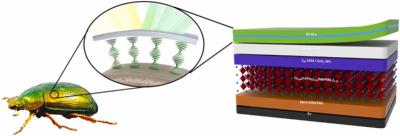Researchers develop a thin and flexible perovskite-based scanner for fingerprints
Researchers from TNO at Holst Centre, Solliance and TU/e have jointly developed a thin and flexible perovskite-based scanner for fingerprints.

Low-resolution image-sensor arrays have been demonstrated in the past, but the high-resolution, high pixel-count image sensors suitable for commercial applications have not yet been truly achieved. The thin and flexible scanner in this new work is based on metal-halide perovskites (MHPs). Gerwin Gelinck, Chief Technology Officer TNO at Holst Centre, elaborates on the new study: 'Perovskites are marvelous materials! For the first time we show that these materials are also very good for light imaging and sensing applications. When combined with display-like transistors, we made a scanner that can capture high-resolution color images as well as biometric fingerprinting'.






